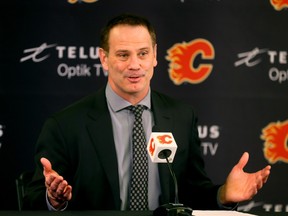Given the transitional phase in which they find themselves, Calgary’s priorities should fall outside of the typical plan of pursuing the top free agents in earnest. With a focus that is more long-term.

Article content
Most teams have a straightforward mission every summer – find and sign the best unrestricted free agents available. From contenders looking to land “the big whale”, to middling clubs seeking to fill gaps all over their roster, the UFA period is an opportunity to take a step or two forward.
In contrast, the Calgary Flames’ relationship with the UFA season will be more complicated this year. With over $20 million in cap space on hand come July, general manager Craig Conroy will certainly have the cap budget to make deals.
Advertisement 2
Article content
Given the transitional phase in which they find themselves, however, Calgary’s priorities should fall outside of the typical plan of pursuing the top free agents in earnest. With a focus that is more long-term and a roster that is unlikely to meaningfully improve with a few veteran additions, the Flames should mostly avoid the feeding frenzy on July 1st.
That doesn’t mean Conroy and company need to sit on their hands indefinitely, just that they will have other paths to follow. The team still has needs to fill, even if they fall slightly outside of the standard off-season efforts.
The first priority will be to sort through the scratch and dent bin. While many of the premier UFA’s won’t (or shouldn’t be) a Flames target, there will no doubt be some guys who are left standing when much of the available cap space has been spent. Practically all of the UFA contracts teams later regret are typically signed within the first week of the free agent frenzy, if not the first few days. Once the dust settles, more than a few competent NHLers are left looking for work and are usually motivated to sign better-value deals as a result.
Article content
Advertisement 3
Article content
These players are usually looking for opportunities to rehabilitate their careers and improve their negotiating power for their next contract. Meaning, they are positioned to be “buy low, sell high” assets. Calgary, in turn, can offer them the possibility to play more minutes, higher in the rotation, and the chance to be dealt at the deadline to a contender in a season or two. The player gets a shot to up his value, while Calgary bets that he can be flipped for futures in the short or medium term.
The Flames should also seek to weaponize its cap space. On top of the $20M currently coming off-the-books, Conroy may add another $6 million in space should one of the rumoured Jacob Markstrom trades come to fruition. That’s a lot of room, which no doubt other clubs could be interested in exploiting.
This doesn’t necessarily mean absorbing abominable deals or completely dead cap space. There are more than a few examples of “cap dumps” turning out to be effective players and useful assets.
In 2021, The Flyers paid a second-round and seventh-round pick to dump Shayne Gostisbehere on the Arizona Coyotes. Gostisbehere immediately slotted into the Coyotes’ top-four and scored at a 0.62 point-per-game average over two seasons with the club. He was flipped for a third-round pick to the Carolina Hurricanes in 2023.
Advertisement 4
Article content
Closer to home, Flames fans no doubt remember when Brad Treliving paid a conditional first-round pick to dump Sean Monahan on the Montreal Canadiens. Monahan scored at a 0.70 point-per-game pace for the Habs and was flipped this past trade deadline for a first and conditional third-round pick. Talk about cleaning up.
Whether it be via free agency or trade, the Flames should prioritize players who are likely to net them futures sooner rather than later. “Distressed assets” in players who are undervalued, underappreciated, or overpaid are the primary opportunities for the Flames this summer.
A supplementary priority will be finding guys who genuinely want play to in Calgary. Due to the max exodus over the last three seasons, the club is facing a culture and perception problem. They may not be close to becoming contenders, but Conroy and the new management regime need to rebuild not just the on-ice product, but the off-ice factors that make this market a play and stay in. This will be admittedly difficult because it depends on there being players who expressly want to play here and be part of the rebuild.
The Flames have 12 forwards, five defenders, and two goalies signed for the 2024-25 season. Their needs in terms of icing a full roster are relatively modest, as are their aspirations for regular success. While most teams will be looking to add key players or fill obvious gaps, Conroy should instead seek ways to help build a futures surplus while continuing to lay a foundation that will ensure future, rather than present, success.
Article content



